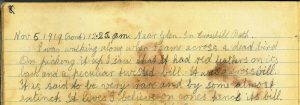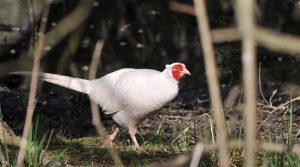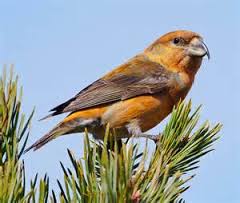Viola is visiting her neighbours at Touch House in the morning and sees a white pheasant. This is likely to be a Leucistic bird rather than a case of albinism, as this is much rarer.
Later, on the same day, Viola finds a dead crossbill and describes its unusual bill shape. As she remarks, this bird has evolved to extract pine nuts from their cones and the shape of its bill allows it to do this easily.
Interestingly, it was discovered in 2006, after the study of crossbills in Scotland, that the Scottish crossbill is a unique sub-species of the common crossbill, found only in Scotland. One of the things that allowed the experts to determine this is the fact that the bird has its own ‘Scottish accent’.
Nov. 5. 1919. Touch House 9.10 a.m.
Saw a white pheasant from a distance
He was in the field in front of the
house right at the top so we could not see him well.
Nov 5 1919 (cont) 12.25. am. Near Glen. In Crossbill Path
I was walking along when I came across a dead bird
On picking it up I saw that it had red feathers on its
back and a peculiar twisted bill. It was a crossbill.
It is said to be very rare and by some almost
extinct. It lives I believe on cones hence its bill.



